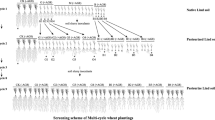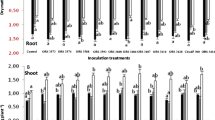Abstract
Aims
Research objectives were to determine nodule-forming capacities and competition for nodule-formation of Frankia strains ArI3 and Ag45/Mut15, which were assessed 90 days after planting of host seedlings in containers within soil microcosms.
Methods
Both strains were inoculated in a ‘4 × 4’ factorial design with all combinations (n = 16) of cell numbers of the two strains (0, 102, 103, or 104 cells g−1 of soil) determined by qPCR.
Results
In all cases, inoculation significantly increased plant height compared to non-inoculated controls. Root nodules were formed on all inoculated plants with strain Ag45/Mut15 alone forming few nodules, for all inoculum amounts whiles strain ArI3 alone formed about ten-times more nodules at the lowest inoculum amount than Ag45/Mut15, with notable increases in nodule numbers for each ten-fold increase in inoculum. Except for nodules formed after inoculation of strain Ag45/Mut15 alone, nodules in all combinations harbored strain ArI3 only. Both strains were detected in rhizosphere soils for all three inoculum amounts. In contrast to nodules and rhizosphere soil, however, strain ArI3 was not detected in any bulk soil samples after three months of incubation, while strain Ag45/Mut15 was detected with densities about ten-fold higher than the original inoculum.
Conclusions
These analyses demonstrate that strain ArI3 is initially more infective and competitive for root nodule formation than strain Ag45/Mut15. Strain Ag45/Mut15, however, survived and increased in cell numbers in bulk soil after 90 days whereas strain ArI3 disappeared indicating a reversal of competitive advantage between these two strains in the soil matrix over time.





Similar content being viewed by others
Data availability
Not applicable.
Code availability
Not applicable.
References
Bais HP, Weir TL, Perry LG, Gilroy S, Vivanco JM (2006) The role of root exudates in rhizosphere interations with plants and other organisms. Annu Rev Plant Biol 57:233–266
Baker DD (1987) Relationships among pure cultured strains of Frankia based on host specificity. Physiol Plant 70:245–248
Ben Tekaya S, Ganesan AS, Guerra T, Dawson JO, Forstner MRJ, Hahn D (2017) Sybr green- and TaqMan-based quantitative PCR approaches allow assessment of the abundance and relative distribution of Frankia clusters in soils. Appl Environ Microbiol 85:e02833–e02816
Ben Tekaya S, Guerra T, Rodriguez D, Dawson JO, Hahn D (2018) Frankia diversity in host-plant root nodules is independent of abundance or relative diversity of Frankia in corresponding rhizosphere soils. Appl Environ Microbiol 84:e02248–e02217
Benson DR, Dawson J (2007) Recent advances in the biogeography and genecology of symbiotic Frankia and its host plants. Physiol Plant 130:318–330
Benson DR, Silvester WB (1993) Biology of Frankia strains, actinomycete symbionts of actinorhizal plants. Microbiol Rev 57:293–319
Bertin C, Yang XH, Weston LA (2003) The role of root exudates and allelochemicals in the rhizosphere. Plant Soil 256:67–83
Burleigh S, Torrey JG (1990) Effectiveness of different Frankia cell types as inocula for the actinorhizal plant Casuarina. Appl Environ Microbiol 56:2565–2567
Core Team R (2021) R: a language and environment for statistical computing. R Foundation for Statistical Computing, Vienna
Crannell WK, Tanaka Y, Myrold DD (1994) Calcium and pH interaction on root nodulation of nursery-grown red alder (Alnus rubra bong.) seedlings by Frankia. Soil Biol Biochem 26:607–614
Dawson JO (1986) Actinorhizal plants: their use in forestry and agriculture. Outlook Agric 15:202–208
Diagne N, Arumugam K, Ngom M, Nambiar-Veetil M, Franche C, Narayanan KK, Laplaze L (2013) Use of Frankia and actinorhizal plants for degraded lands reclamation. Biomed Res Int 2013:948258
Griffiths AP, McCormick LH (1984) Effects of soil acidity on nodulation of Alnus glutinosa and viability of Frankia. Plant Soil 79:429–434
Hahn D, Starrenburg MJC, Akkermans ADL (1988) Variable compatibility of cloned Alnus glutinosa ecotypes against ineffective Frankia strains. Plant Soil 107:233–243
Hahn D, Starrenburg MJC, Akkermans ADL (1990) Growth increment of Alnus glutinosa upon dual inoculation with effective and ineffective Frankia strains. Plant Soil 122:121–127
Haichar FE, Santaella C, Heulin T, Achouak W (2014) Root exudates mediated interactions belowground. Soil Biol Biochem 77:69–80
Hall RB, Mcnabb HS, Maynard CA, Green TL (1979) Toward development of optimal Alnus glutinosa symbiosis. Bot Gaz 140(Suppl):S120–S126
Huss-Danell K, Myrold DD (1994) Intragenic variation in nodulation of Alnus: consequences for quantifying Frankia nodulation units in soil. Soil Biol Biochem 26:525–531
Knowlton S, Dawson JO (1983) Effects of Pseudomonas cepacia and cultural factors on the nodulation of Alnus rubra roots by Frankia. Can J Bot 61:2877–2882
Kohls SJ, Baker DD (1989) Effects of substrate nitrate concentration on symbiotic nodule formation in actinorhizal plants. Plant Soil 118:171–179
Kurdali F, Domenach AM, Fernandez M, Capellano A, Moiroud A, De la Paz-Fernandez M (1988) Compatibility of Frankia spore positive and spore negative inocula with Alnus glutinosa and Alnus incana. Soil Sci Plant Nutr 34:451–459
Kurdali F, Rinaudo G, Moiroud A, Domenach AM (1990) Competition for nodulation and 15N2-fixation between a Sp+ and a Sp- Frankia strain in Alnus incana. Soil Biol Biochem 22:57–64
Markham JH (2009) Variability of nitrogen-fixing Frankia on Alnus species. Botany 87:1011–1011
Martin KJ, Posavatz NJ, Myrold DD (2003) Nodulation potential of soils from red alder stands covering a wide age range. Plant Soil 254:187–192
Maunuksela L, Zepp K, Koivula T, Zeyer J, Haahtela K, Hahn D (1999) Analysis of Frankia populations in three soils devoid of actinorhizal plants. FEMS Microbiol Ecol 28:11–21
Maunuksela L, Hahn D, Haahtela K (2000) Effect of freezing of soils on nodulation capacities of total and specific Frankia populations. Symbiosis (Rehovot) 29:107–120
Meesters TM, van Genesen ST, Akkermans ADL (1985) Growth, acetylene reduction activity and localization of nitrogenase in relation to vesicle formation in Frankia strains Cc1.17 and Cp1.2. Arch Microbiol 143:137–142
Mirza BS, Welsh A, Hahn D (2007) Saprophytic growth of inoculated Frankia sp. in soil microcosms. FEMS Microbiol Ecol 62:280–289
Mirza BS, Welsh A, Rasul G, Rieder JP, Paschke MW, Hahn D (2009a) Variation in Frankia populations of the Elaeagnus host infection group in nodules of six host plant species after inoculation with soil. Microb Ecol 58:384–393
Mirza BS, Welsh AK, Hahn D (2009b) Growth of Frankia strains in leaf litter-amended soil and the rhizosphere of a non-actinorhizal plant. FEMS Microbiol Ecol 70:132–141
Murry MA, Fontaine MS, Torrey JG (1984) Growth kinetics and nitrogenase induction in Frankia sp. HFPArI 3 grown in batch culture. Plant Soil 78:61–78
Nickel A, Hahn D, Zepp K, Zeyer J (1999) In situ analysis of introduced Frankia populations in root nodules of Alnus glutinosa grown under different water availability. Can J Bot 77:1231–1238
Nickel A, Pelz O, Hahn D, Saurer M, Siegwolf R, Zeyer J (2001) Effect of inoculation and leaf litter amendment on establishment of nodule-forming Frankia populations in soil. Appl Environ Microbiol 67:2603–2609
Normand P, Orso S, Cournoyer B, Jeannin P, Chapelon C, Dawson J, Evtushenko L, Misra AK (1996) Molecular phylogeny of the genus Frankia and related genera and emendation of the family Frankiaceae. Int J Syst Bacteriol 46:1–9
Pokharel A, Mirza BS, Dawson JO, Hahn D (2011) Frankia populations in soil and root nodules of sympatrically grown Alnus taxa. Microb Ecol 61:92–100
Pozzi AC, Bautista-Guerrero HH, Nouioui I, Cotin-Galvan L, Pepin R, Fournier P, Menu F, Fernandez MP, Herrera-Belaroussi A (2015) In-planta sporulation phenotype: a major life history trait to understand the evolution of Alnus-infective Frankia strains. Environ Microbiol 17:3125–3138
Prat D (1989) Effects of some pure and mixed Frankia strains on seedling growth in different Alnus species. Plant Soil 113:31–38
Quoreshi AM, Roy S, Greer CW, Beaudin J, McCurdy D, Khasa DP (2007) Inoculation of green alder (Alnus crispa) with Frankia-ectomycorrhizal fungal inoculant under commercial nursery production conditions. Native Plants J 8(3):271–281
Rönkkö R, Smolander A, Nurmiaho-Lassila EL, Haahtela K (1993) Frankia in the rhizosphere of nonhost plants: a comparison with root-associated nitrogen-fixing Enterobacter, Klebsiella and Pseudomonas. Plant Soil 153:85–95
Rosbrook PA (1990) Effect of inoculum type and placement on nodulation and growth of Casuarina cunninghamiana seedlings. Forest Ecol Manag 36:135–147
Samant S, Sha Q, Iyer A, Dhabekar P, Hahn D (2012) Quantification of Frankia in soils using SYBR green based qPCR. Syst Appl Microbiol 35:191–197
Samant S, Amann RI, Hahn D (2014) Evaluation of the 23S rRNA gene as target for qPCR based quantification of Frankia in soils. Syst Appl Microbiol 37:229–234
Samant SS, Dawson JO, Hahn D (2015) Growth responses of indigenous Frankia populations to edaphic factors in actinorhizal rhizospheres. Syst Appl Microbiol 38:501–505
Samant S, Dawson JO, Hahn D (2016a) Growth responses of introduced Frankia strains to edaphic factors. Plant Soil 400:123–132
Samant S, Huo T, Dawson JO, Hahn D (2016b) Abundance and relative distribution of Frankia host infection groups under actinorhizal Alnus glutinosa and non-actinorhizal Betula nigra trees. Microb Ecol 71:473–481
Sanginga N, Danso SKA, Bowen GD (1989) Nodulation and growth response of Allocasuarina and Casuarina species to phosphorus fertilization. Plant Soil 118:125–132
Selim S, Schwencke J (1995) Simple and reproducible nodulation test for Casuarina-compatible Frankia strains: inhibition of nodulation and plant performance by some cations. Arid Soil Res Rehabil 9:25–37
Smolander A, Sarsa ML (1990) Frankia strains of soil under Betula pendula: behaviour in soil and in pure culture. Plant Soil 122:129–136
Smolander A, Sundman V (1987) Frankia in acid soils of forests devoid of actinorhizal plants. Physiol Plant 70:297–303
Vemulapally S, Guerra T, Hahn D (2019) Localization of typical and atypical Frankia isolates from Casuarina sp. in nodules formed on Casuarina equisetifolia. Plant Soil 435:385–393
Weber A, Sarsa ML, Sundman V (1989) Frankia-Alnus incana symbiosis: effect of endophyte on nitrogen fixation and biomass production. Plant Soil 120:291–297
Wheeler CT, Hooker JE, Crowe A, Berrie AMM (1986) The improvement and utilization in forestry of nitrogen fixation by actinorhizal plants with special reference to Alnus in Scotland. Plant Soil 90:393–406
Wheeler CT, Hollingsworth MK, Hooker JE, McNeill JD, Mason WL, Moffat AJ, Sheppard LJ (1991) The effect of inoculation with either cultured Frankia or crushed nodules on nodulation and growth of Alnus rubra and Alnus glutinosa seedlings in forest nurseries. Forest Ecol Manag 43:153–166
Zitzer SF, Dawson JO (1992) Soil properties and actinorhizal vegetation influence nodulation of Alnus glutinosa and Elaeagnus angustifolia by Frankia. Plant Soil 140:197–204
Funding
The authors are indebted to the Graduate College (Doctoral Research Support Fellowship to S. Vemulapally), and the Department of Biology at Texas State University for financial support.
Author information
Authors and Affiliations
Contributions
Not applicable.
Corresponding author
Ethics declarations
Ethics approval
Not applicable.
Consent to participate
Not applicable.
Consent for publication
Not applicable.
Conflicts of interest/competing interests
Not applicable.
Additional information
Responsible Editor: Katharina Pawlowski.
Publisher’s note
Springer Nature remains neutral with regard to jurisdictional claims in published maps and institutional affiliations.
Rights and permissions
About this article
Cite this article
Vemulapally, S., Guerra, T., Weckerly, F.W. et al. Competition of two inoculated Frankia strains in root nodulation of Alnus glutinosa seedlings and associated Frankia-strain growth in rhizospheric and non-rhizospheric soils. Plant Soil 474, 115–124 (2022). https://doi.org/10.1007/s11104-022-05319-2
Received:
Accepted:
Published:
Issue Date:
DOI: https://doi.org/10.1007/s11104-022-05319-2




